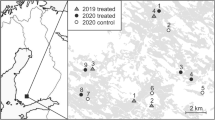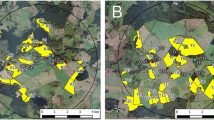Abstract
Residues dynamics of Endosulfan (525.00 g a.i. ha−1), Imidacloprid seed treatment (21 g a.i. kg−1), Lambdacyhalothrin (75.00 g a.i. ha−1) and Spiromesifen (225.00 g a.i. ha−1) in nectar and pollen of mustard, Brassica juncea (L.) Czern. grown in Himachal Pradesh (India) were determined through bioassay (using Drosophila melanogaster Meig. as test organism) and GC (Gas chromatographic) and HPLC (High performance liquid chromatographic) methods. In general chromatographic methods were more sensitive for the determination of above given pesticides compared to bioassay method. Average recoveries in nectar samples varied between 82.85 and 88.90% by bioassay and 91.20 and 93.55% by chromatographic techniques. In pollen samples, recoveries varied between 81.44 and 86.44% by bioassay and 88.50 and 91.30% by chromatographic methods. Imidacloprid residues were neither found in nectar nor in pollen samples at the time of sampling i.e. 50% of flowering. The order of average half life of residues was: Lambdacyhalothrin (12.45 h) < Spiromesifen (19.99 h) < Endosulfan (27.49 h) for nectar and Spiromesifen (9.69 h) < Lambdacyhalothrin (12.44 h) < Endosulfan (17.84 h) for pollen samples. It was found that Imidcloprid seed treatment was practically harmless to honey bees, whereas a waiting period of 5 days must be observed on crops sprayed with these chemicals during blooms to avoid any accidental hazards to honey bees.
Similar content being viewed by others
References
Anderson, L. D., & Atkins, E. L., Jr. (1968). Pesticide usage in relation to beekeeping. Annual Review of Entomology, 13, 213–238.
Anonymous (2005). Oberon product guide. Bayer Crop Science Research Triangle Park NC 27709, 10 pp.
Anonymous (2006). Confederation of Indian Industries Conference in Crop Protection Chemicals and Safety (Forward letter 20th June, 2006).
Atkins, E. L., & Kellum, D. (1986). Comparative morphogenic and toxicity studies on the effect of pesticides on honey bee brood. Journal of Apicultural Research, 25(4), 242–255.
Attri, B. S., & Sharma, O. P. (1969). Toxicity of new pesticides to Indian honey bee (Apis indica F.). Pesticides, 3, 27–29.
Celli, G., & Porrini, C. (1988). Flower morphology and pesticide contamination of nectar (some theoretical considerations). Atti XV Congresso Nazionale Italiano di Entomologia, L’Aquila, 13–17 Giugno 1988, 1039–1045.
Cure, G., Schmidt, H. N., & Schmuck, R. (2001). Results of a comprehensive field research programme with systemic insecticide Imidacloprid (Gaucho). In L. P. Belzunces, C. Pelissier, & G. B. Lewis (Eds.), Proceedings of International Symposium on Hazards of Pesticides to Bee, ICP-IBR Bee Protection Group, held on 7–9 February 1999 at France, 308.
Dalabie, J., Ros, C., Fonta, C., & Masson, C. (1988). Toxic and repellent effects of cypermethrin on the honey bees: Laboratory, glasshouse and field experiments. Pesticide Science, 16(4), 409–415.
Dikshit, A. K., Lal, O. P., Sinha, S. R., & Srivastava, Y. N. (2002). Safety evaluation, persistence and bioefficacy of Imidacloprid and beta cyfluthrin on okra. Part II. Pestology, 26(7), 30–37.
Fries, I., & Wibran, K. (1987). Effects on honey-bee colonies following application of the pyrethroids cypermethrin and PP 321 in flowering oilseed rape. American Bee Journal, 127(4), 266–269.
Gunther, F. A. (1969). Insecticide residues in California citrus fruits and product. Residue Reviews, 28, 1–119.
Hameed, S. F., & Singh, S. P. (1997). Pesticide bee poisoning in changing scenario of Indian agriculture. In R. C. Mishra (Ed.), Perspectives in Indian Apiculture. Agrobotanica,’ 334–362.
Helal, A., Mukherjee, I., Gopal, M., Ametha, O. P., Patel, B. S., & Somchoudhary, A. K. (2005). Multilocational field trials using Imidacloprid as seed treatment to propose its MRL in mustard (Brassica campestris Linn.) leaves. Pestology, 29(7), 15–19.
Jaycox, E. R. (1964). Effects on the honey bees of nectar from systemic insecticide treated plants. Journal of Economic Entomology, 57(1), 31–35.
Kavadia, V. S., & Lal, R. (1967). Dissipation of insecticide residues from crop of Indian rapeseed. Treatment with BHC-WP and lindane-EC. Indian Journal of Agricultural Sciences, 37(5), 419–427.
King, C. C. (1964). Effects of herbicides on nectar secretion. Journal of Apicultural Research, 3, 5–9.
Loper, G. M., & Ross, B. H. (1982). Concentration of methyl parathion from Penncap-M in pollens of various lipid and oil contents. Environmental Entomology, 11(4), 925–927.
Nath, A., & Sharma, D. C. (1985). Pharmacodynamics of Endosulfan in the Indian honey bee, Apis cerana indica F. Indian Journal of Experimental Biology, 23(7), 363–365.
Schmuck, R., Schoning, R., Stork, A., & Schramel, O. (2001). Risk posed to honey bees (Apis mellifera L. Hymenoptera) by an Imidacloprid seed dressing of sunflowers. Pest Management Science, 57(3), 225–238.
Sharma, D. C. (1987). Metabolism of some important chlorinated insecticides through glutathione mediated enzyme system in insects. PhD Thesis submitted to Dr Y.S. Parmar University of Horticulture and Forestry Nauni, Solan (India).
Sharma, S. K. (1997). Persistence of field weathered toxicity of some commonly used insecticides against Apis mellifera L. on mustard. PhD Thesis submitted to CSK Himachal Pradesh Krishi Vishvavidyalaya, Palampur (India).
Shivrana, S., & Jain, K. L. (1994). Effect of low doses of pyrethroids feeding on honey bee mortality and their body sugar levels. Indian Bee Journal, 56(3–4), 145–151.
Tasei, J. N., Lerin, J., & Ripault, G. (2000). Sub-lethal effects of Imidacloprid on bumblebees, Bombus terrestris (Hymenoptera: Apidae), during a laboratory feeding test. Pest Management Science, 56(9), 784–788.
Thakur, A. K., Kashyap, N. P., & Dogra, G. S. (1981). Relative toxicity of some pesticides against Italian bees, Apis mellifera. Indian Bee Journal, 43(4), 101–103.
Thrasyvoulou, A. T., & Pappas, N. L. (1988). Contamination of honey and wax with malathion and coumaphos used against varroa mite. Journal of Apicultural Research, 27(1), 55–61.
Waller, G. D., & Barker, R. J. (1979). Effects of dimethoate on honey bee colonies. Journal of Economic Entomology, 72(4), 549–551.
Waller, G. D., Estesen, B. J., Buck, N. A., Taylor, K. S., & Crowder, L. (1988). A residual life and toxicity to honey bees of selected pyrethroids formulations applied to cotton in Arozona. Journal of Economic Entomology, 81(3), 1022–1026.
Author information
Authors and Affiliations
Corresponding author
Rights and permissions
About this article
Cite this article
Choudhary, A., Sharma, D.C. Dynamics of pesticide residues in nectar and pollen of mustard (Brassica juncea (L.) Czern.) grown in Himachal Pradesh (India). Environ Monit Assess 144, 143–150 (2008). https://doi.org/10.1007/s10661-007-9952-3
Received:
Accepted:
Published:
Issue Date:
DOI: https://doi.org/10.1007/s10661-007-9952-3




